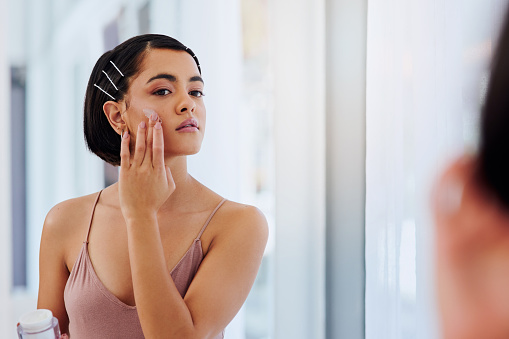Americans spend billions of dollars each year on skin care products that promise to erase wrinkles, lighten age spots, and eliminate itching, flaking, or redness. But the simplest and cheapest way to keep your skin healthy and young looking is to stay out of the sun.
Sunlight is a major cause of the skin changes we think of as aging changes such as wrinkles,Guest Posting dryness, and age spots. Your skin does change with age. For example, you sweat less, leading to increased dryness. As your skin ages, it becomes thinner and loses fat, so it looks less plump and smooth. Underlying structures veins and bones in particular become more prominent. Your skin can take longer to heal when injured.
You can delay these changes by staying out of the sun. Although nothing can completely undo sun damage, the skin sometimes can repair itself. So, it’s never too late to protect yourself from the harmful effects of the sun.
Wrinkles:
Over time, the sun’s ultraviolet (UV) light damages the fibers in the skin called elastin. The breakdown of these fibers causes the skin to lose its ability to snap back after stretching. As a result, wrinkles form. Gravity also is at work, pulling at the skin and causing it to sag, most noticeably on the face, neck, and upper arms.
Cigarette smoking also contributes to wrinkles. People who smoke tend to have more wrinkles than nonsmokers of the same age, complexion, and history of sun exposure. The reason for this difference is not clear. It may be because smoking also plays a role in damaging elastin. Facial wrinkling increases with the amount of cigarettes and number of years a person has smoked.
Many products currently on the market claim to ?revitalize aging skin.? According to the American Academy of Dermatology, over-the-counter ?wrinkle? creams and lotions may soothe dry skin, but they do little or nothing to reverse wrinkles. At this time, the only products that have been studied for safety and effectiveness and approved by the Food and Drug Administration (FDA) to treat signs of sun-damaged or aging skin are tretinoin cream and carbon dioxide (CO2) and erbium (Er:YAG) lasers.
Tretinoin cream (Renova), a vitamin A derivative available by prescription only, is approved for reducing the appearance of fine wrinkles, mottled darkened spots, and roughness in people whose skin doesn?t improve with regular skin care and use of sun protection. However, it doesn’t eliminate wrinkles, repair sun-damaged skin, or restore skin to its healthier, younger structure. It hasn’t been studied in people 50 and older or in people with moderately or darkly pigmented skin.
The CO2 and Er:YAG lasers are approved to treat wrinkles. The doctor uses the laser to remove skin one layer at a time. Laser therapy is performed under anesthesia in an outpatient surgical setting.
The FDA currently is studying the safety of alpha hydroxy acids (AHAs), which are widely promoted to reduce wrinkles, spots, and other signs of aging, sun-damaged skin. Some studies suggest that they may work, but there is concern about adverse reactions and long-term effects of their use. Because people who use AHA products have greater sensitivity to the sun, the FDA advises consumers to protect themselves from sun exposure by using sunscreen, wearing a hat, or avoiding mid-day sun. If you are interested in treatment for wrinkles, you should discuss treatment options with a dermatologist.
Dry Skin and Itching:
Many older people suffer from dry skin, particularly on their lower legs, elbows, and forearms. The skin feels rough and scaly and often is accompanied by a distressing, intense itchiness. Low humidity ? caused by overheating during the winter and air conditioning during the summer ? contributes to dryness and itching. The loss of sweat and oil glands as you age also may worsen dry skin. Anything that further dries your skin ? such as overuse of soaps, antiperspirants, perfumes, or hot baths ? will make the problem worse. Dehydration, sun exposure, smoking, and stress also may cause dry skin.
Dry skin itches because it is irritated easily. If your skin is very dry and itchy, see a doctor. Dry skin and itching can affect your sleep, cause irritability, or be a symptom of a disease. For example, diabetes and kidney disease can cause itching. Some medicines make the itchiness worse.
The most common treatment for dry skin is the use of moisturizers to reduce water loss and soothe the skin. Moisturizers come in several forms ? ointments, creams, and lotions. Ointments are mixtures of water in oil, usually either lanolin or petrolatum. Creams are preparations of oil in water, which is the main ingredient. Creams must be applied more often than ointments to be most effective. Lotions contain powder crystals dissolved in water, again the main ingredient. Because of their high water content, they feel cool on the skin and don?t leave the skin feeling greasy. Although they are easy to apply and may be more pleasing than ointments and creams, lotions don?t have the same protective qualities. You may need to apply them frequently to relieve the signs and symptoms of dryness. Moisturizers should be used indefinitely to prevent recurrence of dry skin.
A humidifier can add moisture to the air. Bathing less often and using milder soaps also can help relieve dry skin. Warm water is less irritating to dry skin than hot water.
Skin Cancer:
Skin cancer is the most common type of cancer in the United States. According to current estimates, 40 to 50 percent of Americans who live to age 65 will have skin cancer at least once. Although anyone can get skin cancer, the risk is greatest for people who have fair skin that freckles easily.
UV radiation from the sun is the main cause of skin cancer. In addition, artificial sources of UV radiation ? such as sunlamps and tanning booths ? can cause skin cancer. People who live in areas of the U.S. that get high levels of UV radiation from the sun are more likely to get skin cancer. For example, skin cancer is more common in Texas and Florida than in Minnesota, where the sun is not as strong.
There are three common types of skin cancers. Basal cell carcinomas are the most common, accounting for more than 90 percent of all skin cancers in the United States. They are slow-growing cancers that seldom spread to other parts of the body. Squamous cell carcinomas also rarely spread, but they do so more often than basal cell carcinomas. The most dangerous of all cancers that occur in the skin is melanoma. Melanoma can spread to other organs, and when it does, it often is fatal.
Both basal and squamous cell cancers are found mainly on areas of the skin exposed to the sun ? the head, face, neck, hands, and arms. However, skin cancer can occur anywhere. Changes in the skin are not sure signs of cancer; however, it?s important to see a doctor if any symptom lasts longer than 2 weeks. Don?t wait for the area to hurt ? skin cancers seldom cause pain.
All skin cancers could be cured if they were discovered and brought to a doctor?s attention before they had a chance to spread. Therefore, you should check your skin regularly. The most common warning sign of skin cancer is a change on the skin, especially a new growth or a sore that doesn?t heal. Skin cancers don?t all look the same. For example, skin cancer can start as a small, smooth, shiny, pale, or waxy lump. Or it can appear as a firm red lump. Sometimes, the lump bleeds or develops a crust. Skin cancer also can start as a flat, red spot that is rough, dry, or scaly.
In treating skin cancer, the doctor?s main goal is to remove or destroy cancer completely, leaving as small scar as possible. To plan the best treatment for each person, the doctor considers the type of skin cancer, its location and size, and the person?s general health and medical history. Treatment for skin cancer usually involves some type of surgery. In some cases, radiation therapy or chemotherapy (anticancer drugs) or a combination of these treatments may be necessary.
Age Spots:
Age spots, or ?liver spots? as they?re often called, have nothing to do with the liver. Rather, these flat, brown spots are caused by years of sun exposure. They are bigger than freckles and appear in fair-skinned people on sun-exposed areas such as the face, hands, arms, back, and feet. The medical name for them is solar lentigo. They may be accompanied by wrinkling, dryness, thinning of the skin, and rough spots.
A number of treatments are available, including skin-lightening, or ?fade? creams; cryotherapy (freezing); and laser therapy. Tretinoin cream is approved for reducing the appearance of darkened spots. A sunscreen or sun block should be used to prevent further damage.
Shingles:
Shingles is an outbreak of a rash or blisters on the skin that may cause severe pain. Shingles is caused by the varicella-zoster virus, the same virus that causes chickenpox. After an attack of chickenpox, the virus lies silent in the nerve tissue. Years later, the virus can reappear in the form of shingles. Although it is most common in people over age 50, anyone who has had chickenpox can develop shingles. It also is common in people with weakened immune systems due to HIV infection, chemotherapy or radiation treatment, transplant operations, and stress.
Early signs of shingles include burning or shooting pain and tingling or itching, generally on one side of the body or face. A rash appears as a band or patch of raised dots on the side of the trunk or face. The rash develops into small, fluid-filled blisters, which begin to dry out and crust over within several days. When the rash is at its peak, symptoms can range from mild itching to intense pain. Most people with shingles have only one bout with the disease in their lifetime. However, those with impaired immune systems ? for example, people with AIDS or cancer ? may suffer repeated episodes.
If you suspect you have shingles, see a doctor right away. The severity and duration of an attack of shingles can be reduced significantly by immediate treatment with antiviral drugs. These drugs also may help prevent the painful aftereffects of shingles known as postherpetic neuralgia. The National Institute of Allergy and Infectious Diseases currently is testing a shingles vaccine at the National Institutes of Health in Bethesda, Maryland. The vaccine they are testing is similar to the one used to immunize against chickenpox. After the shot, some people have had some discomfort around the area of the injection. In addition, a few people have had a low-grade fever. For more information about this study, call 1-800-411-1222.
Bruising:
Many older people notice an increased number of bruises, especially on their arms and legs. The skin becomes thinner with age and sun damage. Loss of fat and connective tissue weakens the support around blood vessels, making them more susceptible to injury. The skin bruises and tears more easily and takes longer to heal.
Sometimes bruising is caused by medications or illness. If bruising occurs in areas always covered by clothing, see a doctor.
Keep Your Skin Healthy
The best way to keep your skin healthy is to avoid sun exposure.
Stay out of the sun. Avoid the sun between 10 a.m. and 3 p.m. This is when the sun’s UV rays are strongest. Don’t be fooled by cloudy skies. Harmful rays pass through clouds. UV radiation also can pass through water, so don’t assume you’re safe if you’re in the water and feeling cool.
Use sunscreen. Sunscreens are rated in strength according to a sun protection factor (SPF), which ranges from 2 to 30 or higher. A higher number means longer protection. Buy products with an SPF number of 15 or higher. Also look for products whose label says: broad spectrum (meaning they protect against both types of harmful sun rays ? UVA and UVB) and water resistant (meaning they stay on your skin longer, even if you get wet or sweat a lot). Remember to reapply the lotion as needed.
Wear protective clothing. A hat with a wide brim shades your neck, ears, eyes, and head. Look for sunglasses with a label saying the glasses block 99 to 100 percent of the sun?s rays. Wear loose, lightweight, long-sleeved shirts and long pants or long skirts when in the sun.
Avoid artificial tanning. Don’t use sunlamps and tanning beds, as well as tanning pills and tanning makeup. Tanning pills have a color additive that turns your skin orange after you take them. The FDA has approved this color additive for coloring foods but not for tanning the skin. The large amount of color additive in tanning pills may be harmful. Tanning make-up products are not suntan lotions and will not protect your skin from the sun.
Check your skin often. Look for changes in the size, shape, color, or feel of birthmarks, moles, and spots. If you find any changes that worry you, see a doctor. The American Academy of Dermatology suggests that older, fair-skinned people have a yearly skin check by a doctor as part of a regular physical exam.
Source: ArticlesFactory.com





















